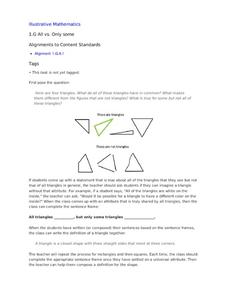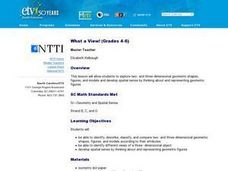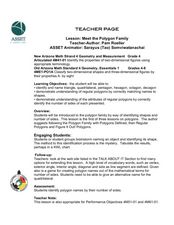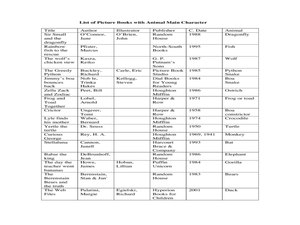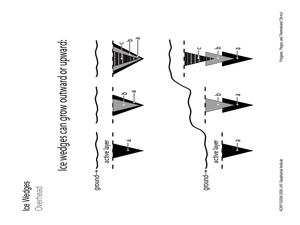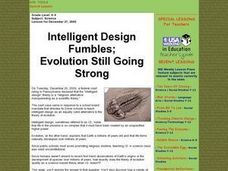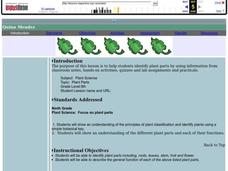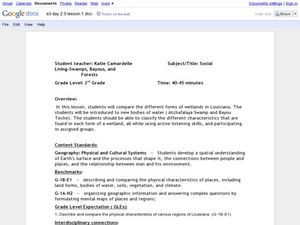Illustrative Mathematics
All vs. Only Some
All shapes have certain defining attributes that set them apart from others. In order to understand this, young mathematicians look at examples and non-examples of triangles, rectangles, and squares, working as a whole class to create...
Curated OER
Compare 2-D Shapes
Second graders explore and analyze plane shapes. In this plane shapes instructional activity, 2nd graders evaluate shape attributes to classify shapes correctly. Students work in groups to create different shapes.
Curated OER
Classifying Three-Dimensional Shapes
Compare geometric solids based on their properties. Your emergent geometers use spaghetti and marshmallows to build models so they can examine the number of faces, edges, and vertices on polyhedra of their own creation. Resource includes...
Curated OER
Poly-Mania
This hands-on lesson takes young geometers on a tour of 2D polygons and 3D polyhedrons. After exploring different web resources and discussing geometric shapes, small groups construct models of polyhedrons using bendable straws. Note:...
Curated OER
Investigation: Sorting and Classifying
Fifth graders explore geometry by creating shapes with construction paper. In this shape characteristics lesson, 5th graders identify the different attributes that make up specific shapes and create them using construction paper, rulers,...
Curated OER
Matters of Milk and Marshmallows
Students observe a teacher demonstration o classifying matter by its physical properties of shape and size. After discussing the definition of matter, students describe the state of matter. They sing a song to the tune of "Bingo." In...
Curated OER
What a View!
Students examine two- and three-dimensional shapes and figures. Individually, they practice identifying the shape from various viewpoints. By completing this activity, they develop a spatial sense about how figures and shapes are...
Curated OER
Identify Polygons: Algebra/Geometry Institute
Eighth graders classify geometric figures. In this polygon lesson, 8th graders identify given geometric figures. They compare and contrast different polygons. Students name line segments, identify parallel lines, and...
Curated OER
Surface Area with Polydrons
Students explore measurements by analyzing geometric shapes. In this surface area instructional activity, students identify the terms volume, weight, perimeter and area in order to find the requested measurements of specific polygons....
Curated OER
Meet the Polygon Family
Fourth graders investigate regular polygons. In this regular polygon instructional activity, 4th graders explore the attributes of different polygons. Students work in groups to complete a KWL chart regarding polygons.
Curated OER
Classifying Rocks
Students classify rocks into groups after they observe the rocks and identify properties that can be used to divide them into groups. They then identify other properties that could be used to classify other objects into groups.
Curated OER
Seed Sensations!
First graders examine seeds. In this Science lesson, 1st graders classify and dissect seeds. Students sprout their own seeds in the classroom.
Curated OER
Find an Animal! Find a Book!
Students identify the themes of different books by classifying their genre. In this genre lesson plan, students examine a specific animal by reading both a nonfiction and fiction book about the species. Students compare the...
Curated OER
Polygons, Pingos, and Themokarst! Oh MY!
Learners complete activities to learn about the common land features in Alaska. In this land study lesson plan, students study an overhead for permafrost features. Learners define ice wedge polygons, thermokarst, and pingos. Students...
Curated OER
Crystals
Students investigate patterns in solids, the structures of crystals and rocks made up of minerals. In this crystals lesson plan, students review solids, make patterns with Styrofoam balls, make crystals in the lab and observe their...
Core Knowledge Foundation
Rocks & Minerals
Take young geologists on an exploration of the rock cycle with this six-lesson earth science unit on rocks and minerals. Through a series of discussions, demonstrations, and hands-on investigations your class will learn...
Curated OER
Cones, Cylinders, Spheres
Students classify polygons by name and shape. For this geometry lesson, students identify the lateral surface of each conic. They differentiate between cones, cylinders and spheres.
Curated OER
Polynomial Functions
Students explore polynomial functions. For this Algebra II lesson, students explore graphs of polynomial functions as classify the functions as linear, quadratic, cubic, or quartic. Students determine the regression equation...
Curated OER
Intelligent Design Fumbles; Evolution Still Going Strong
Students examine how all life is related and how species are classified. They also discover how traits are passed down from one person to the next. They examine the evolution the arthropod has going through.
Curated OER
Plant Parts
Ninth graders identify plant parts by using different classification methods. In this plant lesson plan students observe and draw different types of leaves then classify them according to species.
Curated OER
Rock Identification Lab
Eighth graders compare and contrast the three different types of rock. In this earth science instructional activity, 8th graders classify rock samples according to their correct rock type. They design their own data collection table.
Curated OER
Living Swamps, Bayous and Forests
Third graders explore interesting environments by exploring Louisiana. In this wetland lesson, 3rd graders utilize the web to research the State of Louisiana, the bayous in the area, and the Gulf of Mexico. Students write a journal entry...
Curated OER
It's Not All Greek to Me
Learners find out the meaning for prefixes used in math vocabulary. By dissecting words used in everyday math, they figure out what the prefix indicates and what the word means. A variety of well-organized worksheets and activities...
Curated OER
What is the Rock Cycle and Its Processes?
Geology beginners examine three different rock samples and determine their origin by their characteristics. By making and recording observations, they become familiar with features of igneous, metamorphic, and sedimentary rock types....
